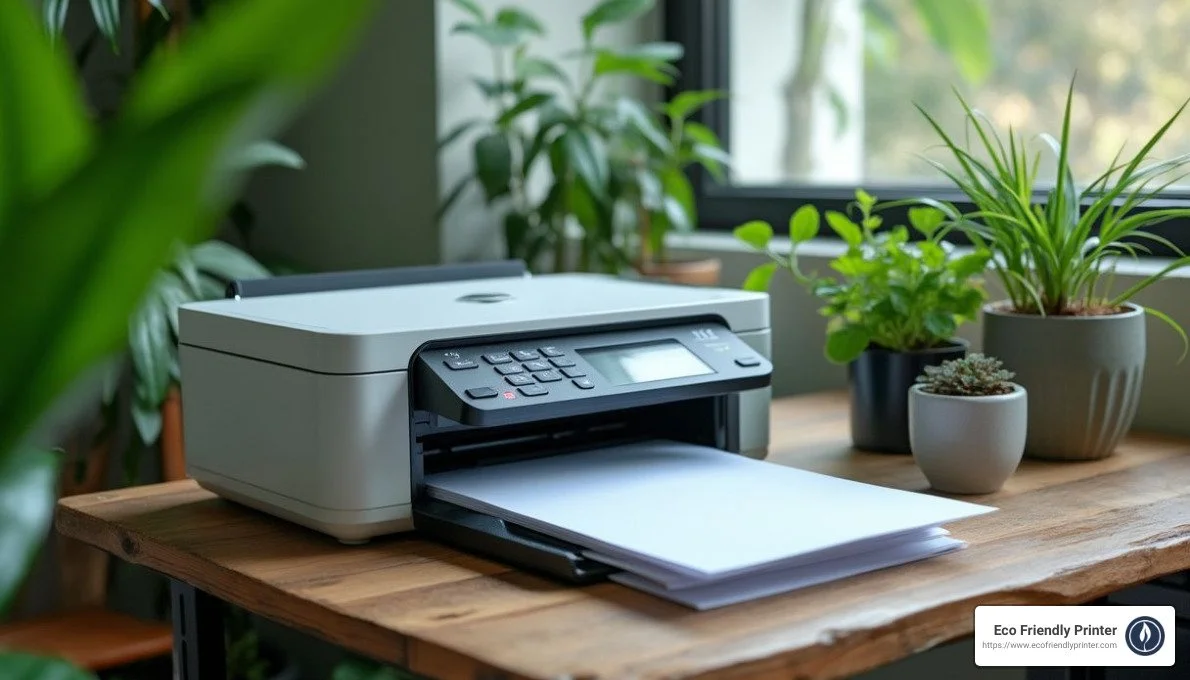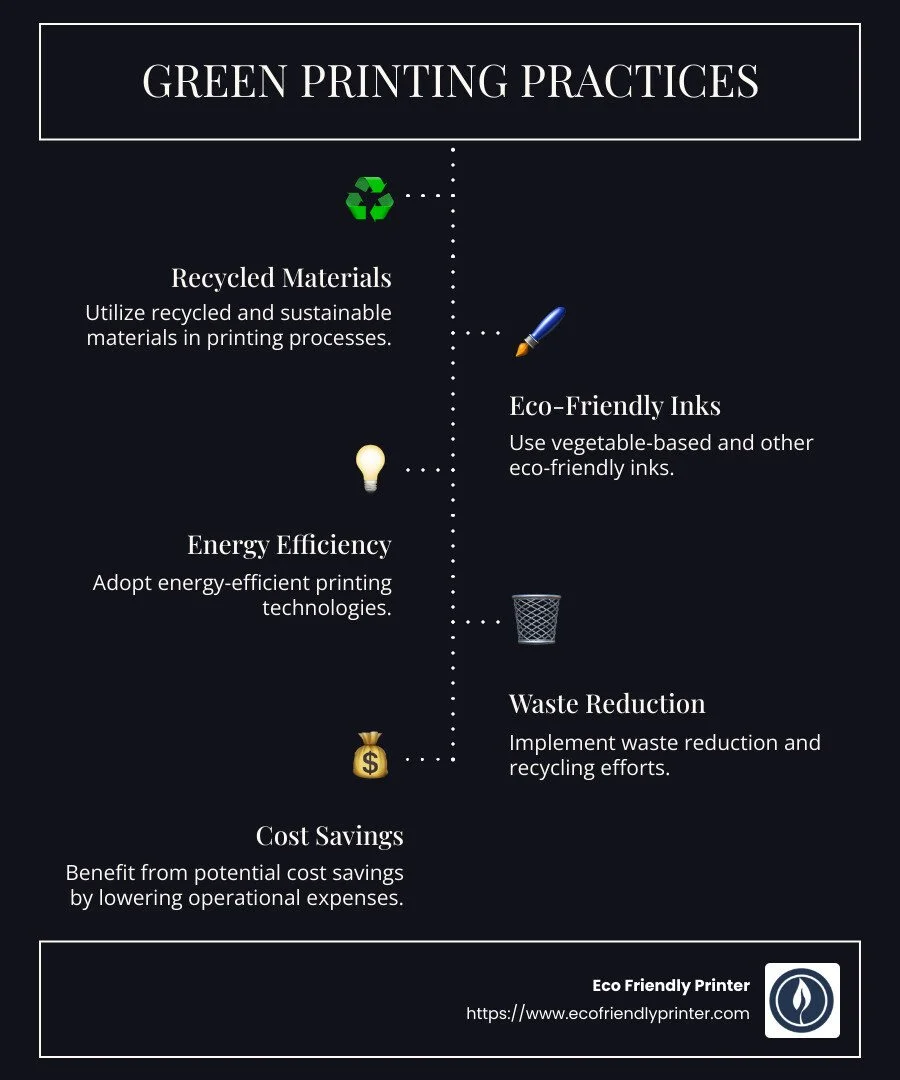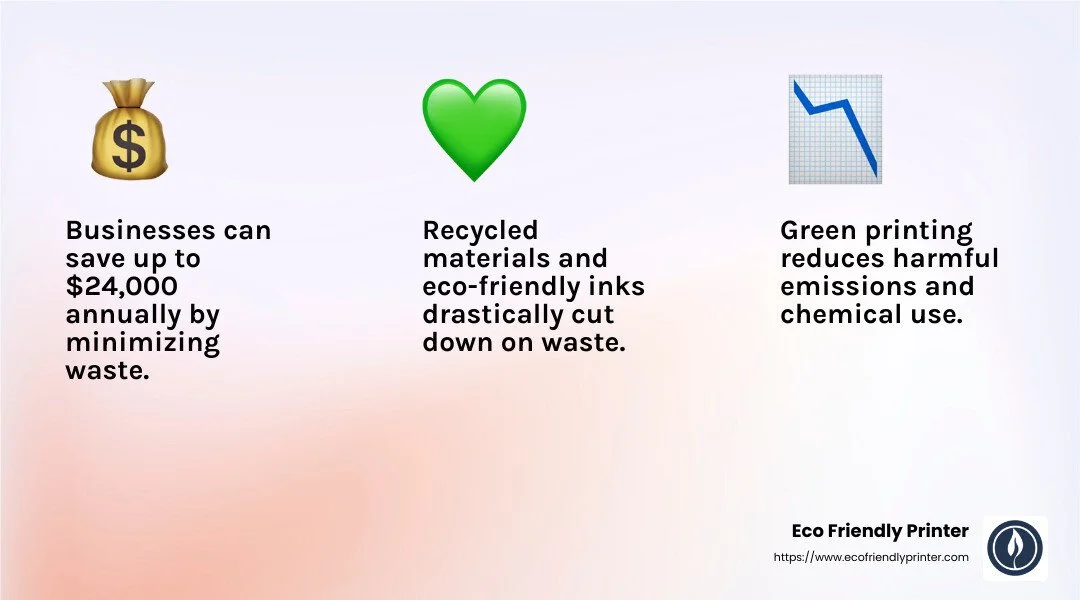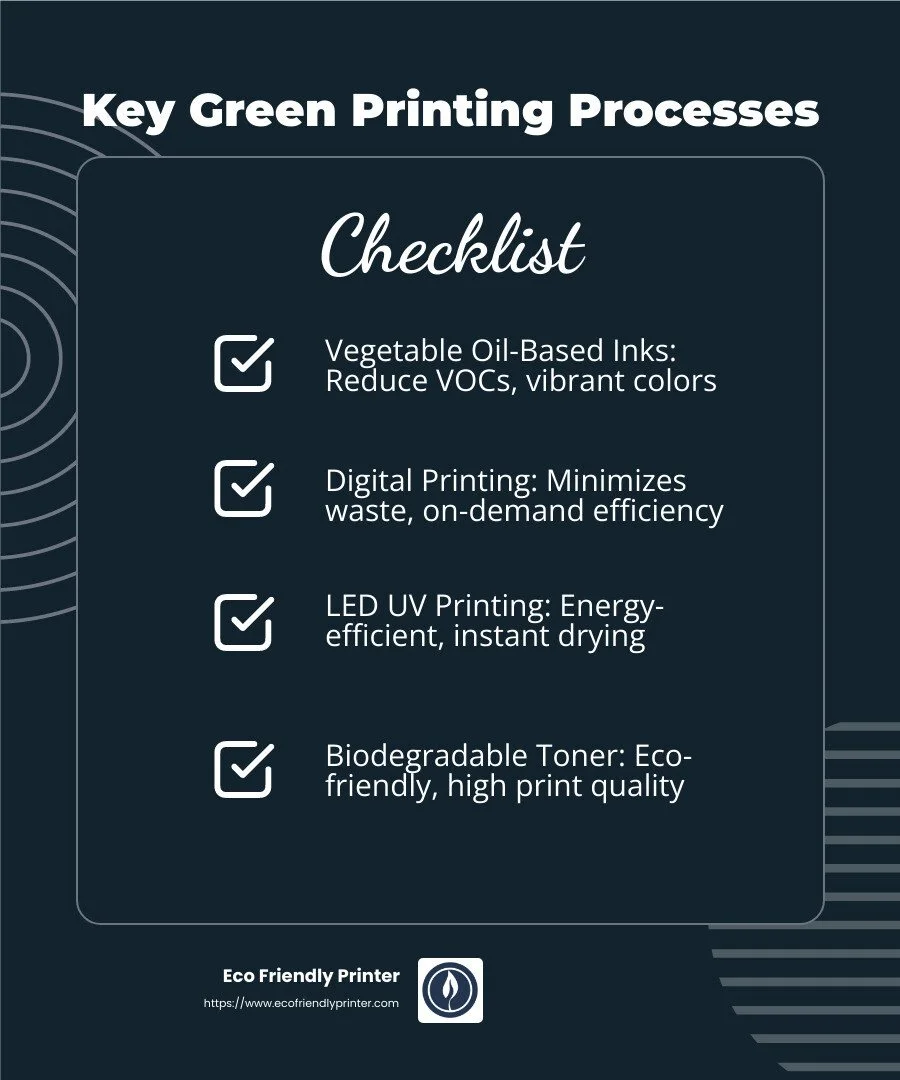Sustainable Printing: How to Make Your Printing Eco-Friendly
Green printing practices are changing the printing industry by combining eco-friendly techniques with traditional methods to minimize environmental harm. At its core, this approach focuses on reducing waste, utilizing renewable resources, and promoting sustainable practices to protect our planet.
For those seeking a quick overview:
Green Printing Practices:
Use of recycled and sustainable materials.
Vegetable-based and eco-friendly inks.
Energy-efficient printing technologies.
Waste reduction and recycling efforts.
As printing is estimated to consume up to three to five percent of a company's operating expenses, integrating these practices not only supports environmental health but also offers potential cost savings.
I'm Greg Barber, founder of Eco Friendly Printer. Early in my career, I became aware of the wastefulness in traditional printing and was motivated to pioneer more sustainable methods. Today, our focus is firmly on leading in implementing green printing practices, ensuring they align with both ethical values and economic goals.
What is Green Printing?
Green printing is a sustainable approach to the printing industry that prioritizes environmental health. It involves using renewable and recyclable materials, reducing waste, and minimizing harmful emissions.
At its core, green printing aims to lessen the environmental impact traditionally associated with printing. This includes the use of renewable energy sources to power printing processes. By shifting away from fossil fuels, companies can significantly reduce their carbon footprint.
Recycled materials play a critical role in green printing. Nearly 76% of U.S. papermakers already incorporate recycled materials into products like packaging, tissue, and office paper. This not only saves trees but also reduces the energy and water needed to produce new paper.
Instead of conventional inks, green printing uses eco-friendly inks such as those made from soy or water-based formulas. These inks contain fewer volatile organic compounds, making them less harmful to both the environment and human health.
By adopting these practices, the printing industry can drastically cut down on greenhouse gas emissions. For instance, companies like The Print Authority have demonstrated the effectiveness of green printing by reducing waste and saving clients thousands of dollars annually.
In summary, green printing is about making smarter choices that benefit both the planet and the bottom line. By embracing these practices, businesses can produce high-quality prints while contributing to a healthier environment.
Benefits of Green Printing Practices
Switching to green printing practices offers a host of benefits that go beyond just being environmentally friendly. Let's explore how these practices can positively impact your business.
Cost-Effective
Green printing can be more cost-effective than traditional methods. By reducing waste and utilizing recycled materials, businesses can cut down on expenses. For example, The Print Authority reported saving clients nearly $24,000 annually by minimizing obsolete materials. Reducing waste not only saves money but also streamlines operations, making them more efficient.
High-Quality
There's a common misconception that eco-friendly products compromise on quality. However, this isn't the case with green printing. Sustainable practices deliver the same high-quality results as conventional methods. Advanced technologies like digital printing and eco-friendly inks ensure that your marketing materials are vibrant and professional.
Waste Reduction
One of the core benefits of green printing is waste reduction. By using recycled paper and eco-friendly inks, companies significantly cut down on waste. The Print Authority, for instance, recycles 100% of their printing plates and reuses packaging materials, demonstrating a commitment to minimizing waste.
Environmental Protection
Green printing practices protect the environment by reducing harmful emissions and chemical use. Traditional printing releases toxic chemicals into the air, soil, and water. In contrast, green printing uses biodegradable toners and chemistry-free plate systems, reducing the environmental impact.
Brand Image
Adopting green printing can improve your brand image. Consumers are increasingly drawn to companies that prioritize sustainability. By positioning your brand as eco-friendly, you can attract more customers and improve your reputation. This not only boosts customer loyalty but also sets you apart from competitors.
Regulatory Compliance
Finally, green printing helps businesses stay compliant with environmental regulations. As governments worldwide tighten regulations on waste and emissions, adopting sustainable practices ensures your business stays ahead of the curve. This not only avoids potential fines but also demonstrates corporate responsibility.
Incorporating green printing practices is a smart move for businesses looking to save costs, produce high-quality materials, and protect the environment. This approach not only benefits the planet but also strengthens your brand and keeps you compliant with regulations.
Green Printing Processes
When it comes to green printing practices, the process is as important as the materials used. Let's explore some of the innovative techniques that are making printing more sustainable.
Vegetable Oil-Based Inks
Traditional inks are petroleum-based and release volatile organic compounds (VOCs) into the atmosphere. In contrast, vegetable oil-based inks, such as soy-based inks, are derived from renewable resources. They contain fewer VOCs, making them less harmful to the environment. These inks are not only eco-friendly but also produce vibrant colors, ensuring your prints are both green and eye-catching.
Digital Printing
Digital printing is a game changer in sustainable printing. Unlike traditional methods that require plates and produce significant waste, digital printing is more efficient and less wasteful. It allows for on-demand printing, which means you only print what you need, reducing excess and saving resources. Additionally, digital printers are often energy-efficient, further minimizing their environmental impact.
LED UV Printing
LED UV printing is a cutting-edge technology that uses LED lights to cure or dry the ink instantly. This method is more energy-efficient compared to traditional UV printing, which uses mercury lamps. The instant drying process reduces power consumption and eliminates the need for solvents, making it a cleaner, greener option. LED UV printing also delivers excellent print quality, making it a popular choice for businesses looking to reduce their ecological footprint without sacrificing results.
Biodegradable Toner
Conventional toners can be harmful to the environment due to their chemical composition. Biodegradable toners, however, are made from natural materials that break down more easily, reducing their environmental impact. These toners are designed to work with modern printers, offering an eco-friendly alternative that doesn't compromise on print quality.
Chemistry-Free Plate System
In traditional offset printing, plates are used to transfer ink onto paper. These plates often require chemical processing, which can be harmful to the environment. A chemistry-free plate system eliminates the need for these chemicals, reducing toxic waste and emissions. Companies like The Print Authority have adopted this system, demonstrating a commitment to sustainable practices. By using chemistry-free plates, businesses can produce high-quality prints while minimizing their environmental impact.
Incorporating these green printing processes into your operations not only benefits the environment but also improves the quality and efficiency of your printing. As technology advances, the options for sustainable printing continue to expand, offering businesses more ways to go green.
Next, we'll dive into Eco-Friendly Paper Practices, exploring the use of recycled and carbon-neutral paper to further reduce your ecological footprint.
Eco-Friendly Paper Practices
Paper is a big part of printing, and choosing the right type can make a huge difference for the environment. Let's explore some eco-friendly paper practices that can help reduce your ecological impact.
Recycled Paper
Recycled paper is made from post-consumer waste, which means it's produced from materials that have already been used and recycled. This process saves trees and reduces the amount of waste sent to landfills. When choosing recycled paper, look for options with a high percentage of post-consumer content to maximize environmental benefits.
Carbon-Neutral Paper
Carbon-neutral paper is manufactured in a way that offsets the carbon emissions produced during its production. This is achieved by investing in renewable energy projects or planting trees to absorb carbon dioxide. Using carbon-neutral paper helps reduce your overall carbon footprint and supports global efforts to combat climate change.
Tree-Free Paper
Tree-free paper is made from alternative fibers like bamboo, hemp, or agricultural residues, rather than traditional wood pulp. These materials grow quickly and are more sustainable than trees, making them an excellent choice for eco-conscious businesses. Tree-free paper is just as versatile and high-quality as regular paper, but with a much lower environmental impact.
Post-Consumer Waste
Post-consumer waste refers to materials that have been used by consumers and then recycled. Incorporating paper with a high percentage of post-consumer waste into your printing practices helps close the recycling loop and reduces the need for virgin materials. This not only conserves resources but also reduces pollution and energy consumption associated with paper production.
Renewable Energy
Many paper manufacturers are now using renewable energy sources, such as wind or solar power, to produce their products. By supporting companies that prioritize renewable energy, you're helping to reduce the reliance on fossil fuels and promote cleaner energy production.
Choosing the right paper is a simple yet effective way to make your printing more sustainable. By opting for recycled, carbon-neutral, or tree-free paper, you can significantly reduce your environmental footprint while still achieving high-quality prints.
In the next section, we'll provide practical tips for implementing green printing in your office, from using eco-friendly ink to adopting modern printers.
8 Tips for Implementing Green Printing in Your Office
Making your office printing more sustainable doesn't have to be complicated. Here are eight simple yet effective green printing practices you can start today:
1. Use Sustainable Paper
Switch to paper made from recycled materials or post-consumer waste. This helps save trees and reduces landfill waste. Look for paper certified by organizations like the Forest Stewardship Council (FSC) to ensure it's sustainably sourced.
2. Choose Eco-Friendly Ink
Traditional inks can be harmful to the environment. Instead, opt for vegetable or soy-based inks. These are more biodegradable and less toxic, reducing your ecological impact.
3. Reduce Waste
Encourage digital proofs instead of physical ones to cut down on unnecessary printing. Train employees on efficient printing practices and make sure they know how to use print settings to minimize waste.
4. Recycle Toner Cartridges
Don't throw away empty toner cartridges. Many manufacturers and third-party organizations offer recycling programs. Recycling cartridges helps prevent them from ending up in landfills and reduces the need for new materials.
5. Track Printing
Implement print management software to monitor your office's printing habits. This can help you identify areas for improvement, such as reducing excessive printing and minimizing paper jams.
6. Enable Double-Sided Printing
Set your printers to default to double-sided (duplex) printing. This simple change can reduce paper use by up to 50%. It's an easy way to make a big impact on reducing paper consumption.
7. Invest in Eco-Friendly Print Services
Consider outsourcing to a print service that prioritizes sustainability. Look for vendors that use renewable energy, recycled materials, and eco-friendly practices in their operations.
8. Upgrade to Modern Printers
Newer printers are designed with energy efficiency in mind. They consume less power and often come with eco-printing modes. Investing in modern equipment can reduce your energy usage and improve your office's sustainability.
By implementing these tips, you can make a significant difference in reducing your office's environmental footprint. Not only will you be helping the planet, but you'll also likely see cost savings and an improved brand image.
In the next section, we'll address some frequently asked questions about green printing practices to help you understand how these changes can benefit your company.
Frequently Asked Questions about Green Printing Practices
What are green printing practices?
Green printing practices are environmentally friendly methods used in the printing industry. These practices aim to reduce waste, lower energy consumption, and minimize harmful environmental impacts. Key components include:
Vegetable oil-based inks: Unlike traditional inks, these are made from renewable resources and are more biodegradable, reducing toxic emissions.
Recycled paper: Using paper made from post-consumer waste helps conserve natural resources and reduces landfill waste.
Digital printing: This method uses less energy and produces less waste compared to traditional printing techniques.
LED UV printing: A technology that uses LED lights to cure inks, consuming less power and offering faster drying times.
Biodegradable toner: Toners that break down more easily in the environment, reducing their ecological footprint.
How can green printing benefit my company?
Adopting green printing practices can offer numerous advantages to your business:
Cost savings: By reducing waste and energy consumption, companies can lower operating costs. For instance, using recycled paper and digital printing can cut material costs.
Brand image: Customers increasingly prefer businesses that demonstrate environmental responsibility. Embracing sustainability can improve your brand's reputation and attract eco-conscious clients.
Regulatory compliance: As environmental regulations become stricter, companies that adopt green practices are better positioned to comply with these requirements.
Environmental protection: By reducing your company's carbon footprint and waste, you're contributing to a healthier planet.
What are some examples of green printing methods?
Several innovative methods are making printing more sustainable:
LED UV printing: This method is energy-efficient and reduces emissions by using LED lights instead of traditional UV lamps.
Recycled paper: Opt for paper that has been previously used and processed for reuse, helping to conserve natural resources.
Digital printing: Ideal for short runs and customization, this method minimizes waste by printing only what you need.
Carbon-balanced paper: Some papers offset their carbon footprint by supporting environmental projects, making them a sustainable choice.
Uncoated paper: Often more environmentally friendly as it requires fewer chemicals and resources during production.
These methods not only help the environment but also provide high-quality results that can meet or exceed traditional printing standards. By incorporating these practices, your company can enjoy both ecological and economic benefits.
Conclusion
At Eco Friendly Printer, our commitment to sustainability sets us apart in the printing industry. We believe that high-quality prints and minimal environmental impact can go hand in hand. Our approach focuses on integrating eco-friendly materials and cutting-edge technologies to deliver exceptional results without compromising the planet.
We use vegetable oil-based inks, which are not only renewable but also more biodegradable than traditional inks. This choice significantly reduces toxic emissions and supports a healthier environment. Additionally, our use of recycled paper conserves natural resources and minimizes landfill waste, aligning with our dedication to sustainable practices.
Our digital printing solutions are designed to use less energy and produce less waste. This method is perfect for short runs and customization, ensuring that we print only what you need. By embracing LED UV printing, we further our energy efficiency, using LED lights that consume less power and provide faster drying times.
Moreover, our commitment extends to using biodegradable toner and implementing a chemistry-free plate system. These innovations reduce harmful chemicals and waste, reflecting our promise to protect the environment.
By choosing Eco Friendly Printer, you are not only opting for superior quality prints but also contributing to a sustainable future. We invite you to learn more about our eco-friendly services by visiting our Eco Printing page. Together, we can make a positive impact on the planet while meeting your printing needs.





